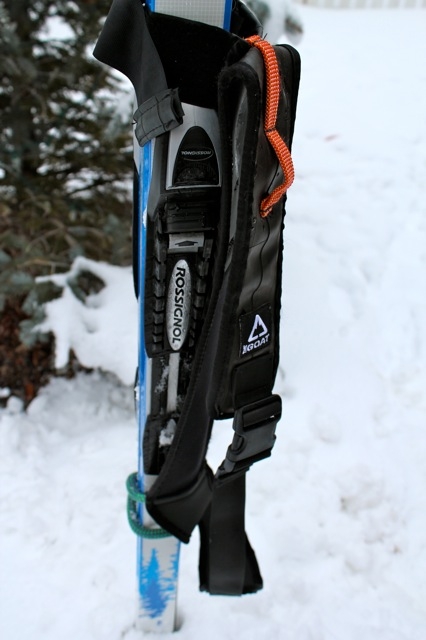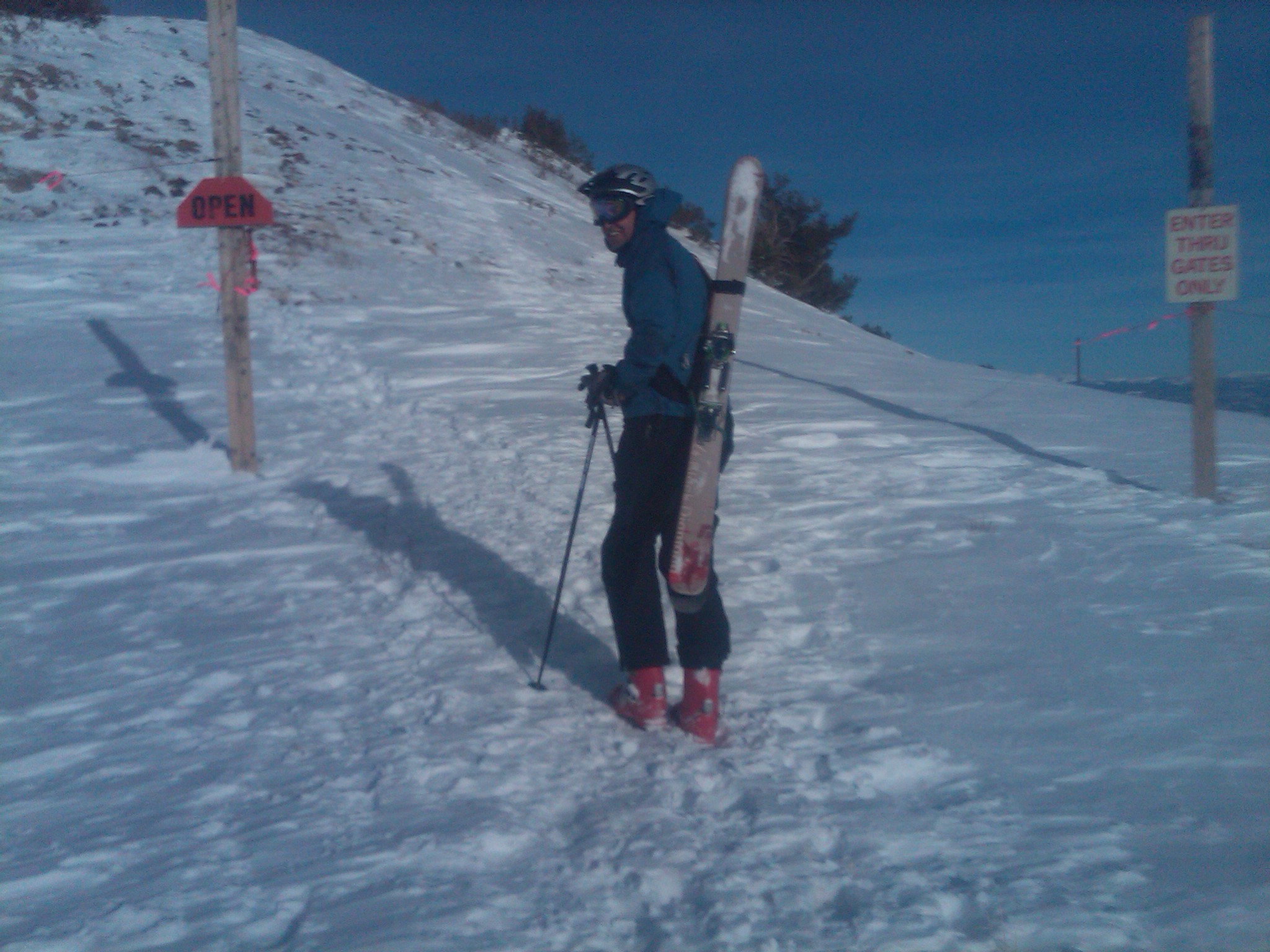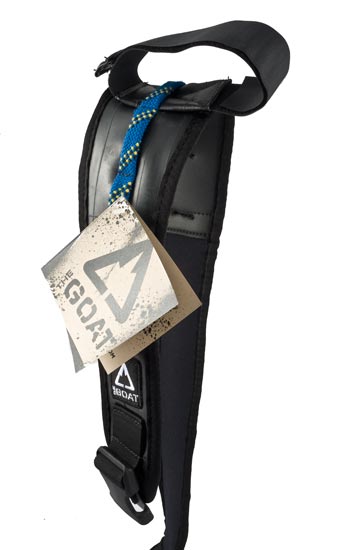Attention everybody who either lives in Aspen, or will be traveling to the area. Make sure you pay a visit to Ute Mountaineer. This is the place to go to set up a guided trek, or to pick up some sweet mountianeering gear. Need to get The Goat? This is the place! See you in Aspen.
Swarm debuts the new seat collar bottle opener
Swarm debuts the seat post bottle opener. Clever products designed by enthusiasts. Forget your bottle opener, not to worry. Be prepared with the Elixir and nectar, from Swarm Products. Never go thirsty for lack of a bottle opener. Cheers!!
Cross Country Ski sling!
Get your GOAT here.
Check out the GOAT on Tahoe Mountain Sports website. If you have used the GOAT why not leave a comment.
the Goat at Jupiter Peak
Using Kickstarter to fund projects
Kickstarter is awesome. For those of you unfamiliar with Kickstarter, head over to their website and browse around for a little while. You'll quickly get the idea. For those of you who have participated- either by funding a project, or by submitting a project, you know what I'm talking about. Kickstarter is awesome. The concept is simple- provide a platform where people with creative ideas can show them to the public and beg for money, and let ordinary people participate in the rewarding process of making it happen. Until just recently, this process took place behind closed doors with angel investors and venture capitalists. This new "crowdfunding" is a completely different way of going about the funding process. It puts idea people in direct contact with the consumer. It allows people who may not have trust funds to participate in making somebody's dream a reality. It is a beautifully simple way of letting the market decide which ideas are worthy of making it beyond the napkin sketch, and into our lives.
From a designer's perspective, I can tell you that this model has several appealing features:
1. It allows the designer to fund his idea without having to give up equity.
This is perhaps the greatest downside to bringing investors on board to fund a project. Risk deserves reward, and usually the only compensation that a startup can offer an investor to counter the risk that they take is an equity stake in the company. The potential downside, though, is that once equity is divided, creative control is spread around. This is not always a negative, and equity partnerships are often a fantastic way to leverage the knowledge and experience that the investor brings to the table. For the designer who doesn't want to give up equity, though, crowdfunding offers a solid way to keep that equity while raising the necessary capital.
2. It puts you in direct contact with your customers.
One of the hurdles that a designer must overcome is figuring out who the potential customers are, and how best to get the design to them. The customer might be the lady buying the product at the store, the kid shopping online, the couple going to an art gallery, concert goers, or the grandma with a passion for beatboxing. As a designer, you must find the people interested in what you have to offer, and communicate your design with them. With kickstarter, people who are genuinely interested in your design are the ones that will fund the project. This is your customer base. If it takes off on kickstarter, it will succeed on the open market. If it fails to achieve the funding necessary, perhaps the project needs to be reevaluated.
3. Pre-orders!
One of the reasons to raise startup capital is to secure enough funding to cover initial orders for product. Manufactures are not charities, and initial orders can be very expensive. Consider the iPhone 4. Estimates put Apple's preorder at about 600,000 units. I don't know what the FOB pricing is for the iPhone 4 at Foxconn in Shenzhen, China, but it has been estimated that the parts alone cost $187.51. Add labor, manufacturing, shipping, and duty, and the landed cost could reasonably be on the order of $300 per unit. That means that the opening order for Apple would cost $180,000,000. That's a lot of cash to lay out. The beauty of kickstarter is that you can treat the funds raised as pre-orders. This is a popular way to reward donors- offer them a free product for their contribution. This, my friends, is a pre-order.
All this is just talk. Let's look at how these 3 points apply to a real world project funded through kickstarter.
LunaTik and TikTok by Scott Wilson of MNML in Chicago have taken the blogosphere by storm. As of press time, the project has raised $765,354 of the requested $15,000. Clearly MNML has hit a home run with their design, and this project will be a great commercial success. By funding it on kickstarter, not only did they get the capital necessary without giving up equity, but they confirmed that their product has a large, passionate market. They have essentially sold several thousand units before ever producing one. They didn't have to give up equity, they confirmed that their product has a strong market, and they secured the pre-orders necessary for a manufacturing run.
Kickstarter is a very successful implementation of the new crowdfunding model. It is a way for people with ideas to connect with potential customers, and get the funding and initial market research necessary to move their projects forward. We at Swarm are excited about this potential, and have 2 projects that we're planning to launch using Kickstarter. One is internal (the bottle opener seat collar), and one is for a client. We think that this is a powerful platform to help launch products, and will use these two projects to test the waters. Stay tuned as we'll keep you updated as we go through the process!
Prosthetic tentacle
Check out this design project by Kaylene Kau on Coroflot. She has taken the traditional prosthetic arm and shaken it all up.

Why make a complicated mechanical hand with actuaries and joints when you can just make a simple tentacle? And besides, who wouldn't want a sweet sweet robo-tentacle? If I was missing an arm I'd definitely go for it!
The beauty of this design is that it is willing to break from tradition and try a completely new way of giving amputees some dexterity. Instead of creating a complex duplicate of the missing part, she has opted to augment the human form with octopus technology. Mechanically this is a much simpler solution- built like one giant finger with many joints instead of an entire hand. Two "tendons" and a simple motor are all that are necessary.
More photos after the jump.
Great design, Kaylene! Via Wired.
Behavioral design
Today I had the extreme misfortune of having to sit through some dysfunctional corporate board meetings. Thankfully, the wireless signal was strong, and I was able to catch up on some of my blog reading. I was looking at the last few days of Gizmodo's posts, and came across the brilliant winner of a Volkswagen design contest. Volkswagen called the contest their "Fun Theory" series. The point of the theory, according to Kyle VanHemert, is that "people will do the right thing if you make the right thing fun to do."
The winning entry was brilliantly simple- set up a traffic camera that sends tickets to speeders, and puts law keepers in a contest to win that money. Basically, by driving the speed limit, you are entered into a lottery to win the revenue from the tickets sent to speeders. As VanHemert so eloquently states, "automatic auto-karma."
Most amazing product ever- coming soon...
In the coming weeks Swarm is going to be releasing what may prove to be the most amazing product in the history of the world. First there was the wheel in 4,000 BC. For thousands of years people ignored its true potential until the summer of 1817 when the good Baron Karl von Drais decided to put two wheels together to create what would eventually become the bicycle. Over the following two centuries people made incremental improvements on his design, and slowly the technology progressed to its current state. Bikes have been designed to meet a variety of needs within human society- transportation, fitness, delivery, getting there on time, population control, and being just like all the different people.
Following roughly the same timeline as the wheel, beer is thought to have been developed around 3,500 BC in the area that is now Iran.
Though beer and bikes have been following parallel paths for thousands of years, and beer has often been linked closely with the subculture that sprang up around bicycles, the two have always been separate.
Swarm has finally bridged the gap. We have developed the most important device known to mankind since the invention of both the wheel and beer. What is it? We can't tell you. We can, though, say that it will make biking more rewarding...
Sneak preview after the jump.
Make: Online "Tag Your Green" contest
Attention everybody- we at Swarm have officially entered The Goat into the "Tag Your Green" contest over at Make: Online. Make sure to vote for it here!











